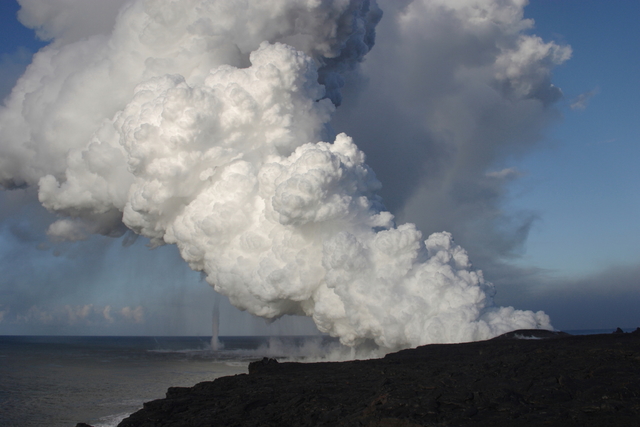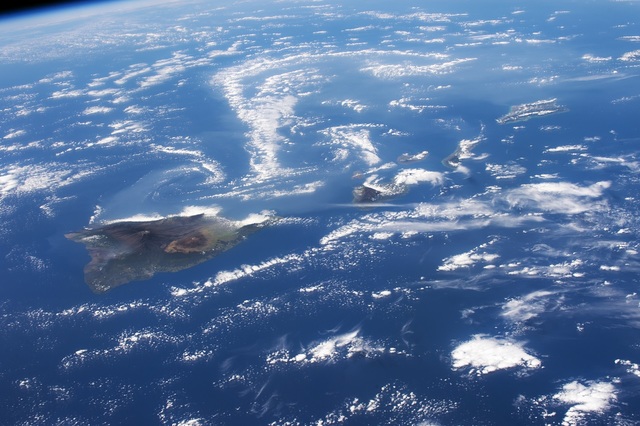Many island residents can expect their red eyes, scratchy throats, stuffy heads, and/or labored breathing to stick around for the next few days, as a light tradewind pattern means heavy vog in some areas. ADVERTISING Many island residents can expect
Many island residents can expect their red eyes, scratchy throats, stuffy heads, and/or labored breathing to stick around for the next few days, as a light tradewind pattern means heavy vog in some areas.
When it comes to impacts from the volcanic gases and particles emanating from the active eruption at Kilauea volcano, the windward side of the island usually gets off easy. The regular trade winds from the northeast typically blow the sulfur dioxide and other particulates from the vent at Puu Oo out to sea or toward Kona.
But when those winds die down, the vog can accumulate, creating a thick haze that creates bothersome conditions for many people, and that’s what is happening this week in East Hawaii, according to National Weather Service meteorologist Maureen Ballard.
“We do have a high-pressure system northeast of the island, as you can tell,” she said. “The winds are a lot weaker than they were a few days ago, and once the winds start shifting around and they’re light, you do get some of that vog coming down the ridge into town. That will be the case for the next few days.”
The trades are expected to pick up again Wednesday evening or into Thursday, she said.
“A new high has formed to the northwest of the state and is pushing in. As it pushes in to the island, you’ll start to see the trades building back up. It’s not going to be an instantaneous thing, but eventually it will pick back up to clear out whatever (vog) has accumulated,” she said.
Ballard explained that vog conditions can be difficult to pinpoint at any given time, as its accumulation depends on many factors on a given day, including wind direction and intensity, as well as the output from the volcano vent.
The University of Hawaii at Manoa Vog Measurement and Prediction Project uses a computer model, paired with weather forecast models, to attempt to predict where vog will go.
Located at weather.hawaii.edu/vmap, the project’s website shows anticipated levels of sulfur dioxide at various locations on the island over a period of several days.
Meanwhile, the state Department of Health site, hiso2index.info, shows current sulfur dioxide levels.
Mark Kimura, a University of Hawaii at Hilo researcher, wrote last month about his experiences with vog in a posting on Vog Talk, a Facebook page dedicated to information and discussion about Hawaii Island vog.
“I live in Hilo. I usually notice my symptoms first when I wake up even before I become aware of the vog,” he said. “I often think I just got sick or maybe my neighbor (is) burning something. Then when I start walking my dogs, I realize it goes beyond my neighborhood and the sky looks a bit different. Vog seems to affect my sleep and mood throughout the day (or a few days). Since it usually lasts only for a few days, I don’t do anything about it. My house has so many openings, so I don’t think an air purifier would work.”
Claire Horwell, director of the International Volcanic Health Hazard Network and a researcher at Durham University in the U.K., started the Vog Talk page as part of her ongoing research project on Hawaii Island to catalogue how residents deal with the vog effects.
On island for about three months so far, Horwell said Monday she anticipates she will have completed about 150 surveys of Hawaii Island residents once the research is done in two weeks.
“During that time I’ve met with several focus groups and agencies about giving out advice about the vog,” she said.
Interestingly, where people live on the island has a lot to do with how they combat the vog, she said.
“So far, there are interesting patterns emerging how different communities are affected depending upon location and elevation,” she said. “Official advice focuses on people reducing physical activity, going indoors and closing all their doors and windows and sealing the house up. And that is something that is very possible in a place like Volcano, where homes have paned glass and they can shut the windows and doors. Whereas in somewhere like Ocean View or Kona, where it’s hotter, the houses simply aren’t designed to be shut up. … So that advice may not be so helpful.”
Horwell said she hopes to secure funding to return to the island to present her findings once she’s had a chance to analyze her data.
“The findings will definitely be relevant,” she said. “It’s not uncommon for people to be exposed to volcanic gases in places around the world. But here it’s a little different because of the constant degassing that’s been going on here over a number of years. And it’s not as easy to study elsewhere as it is in Hawaii.”
Hawaii Island’s differing environments and elevations also provide a wide variety of methods for dealing with vog that can be applied to many different locations around the world, she said.
“It represents a lot of different communities,” she said.
Email Colin M. Stewart at cstewart@hawaiitribune-herald.com.




